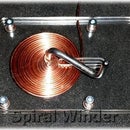Introduction: Kelvin Mixer
Are you as tired of having to deal with (mostly blue-) tinting in post processing, of the photos for your instructables and other product photos?
There are at least a couple of devices with similar end goals, both here and around the web, but they all need microcontrollers and programming skills, which is not for everyone.
This device is very simple to both make and use, as long as you can solder a cheap through-hole chip (4093) onto a board, whether you prefer matrix board or a real PCB.
I will start with some logic theory, although just the bare minimum needed to understand how it works and you can skip it, if you already know and/or only came for the end result.
Step 1: How Logic Gates Work
Fig. 1 shows the most basic "gate" - not really a gate as there's no pins that can be used to gate a signal - it simply inverts a signal, so when the input (left side) is at "0" the output will be at "1" and v.v.
"0" means 0V and "1" means whatever positive voltage you use in your system (within the capability of the components, which, in general, is 15V for the CMOS 4000-series.
Fig. 2 is a NAND gate and it is a true gate. The "N" (meaning "NOT") in the name indicates that the output is negated/inverted and it is otherwise an AND gate. Its output is (Negated) input A multiplied with input B (we like to name digital inputs A, B, C and so on, to tell them apart). So, when (and only when) both inputs is "1", the output goes to "0" (remember it is negated) and all other combinations yield a "1" on the output.
Figs. 3 and 4 shows their counterparts, but with Schmitt triggers (hysteresis) added, which, among other nice things, means that you can make an oscillator from it.
Fig. 5 shows the simplest oscillator that can be constructed this way. It will have a Duty Cycle (M:S ratio) of close to 50%
Fig. 6 finally gives an example on how to change the duty cycle of the simple oscillator, by providing more current during the capacitors charge phase through the diode.
Step 2: Continously Variable Duty Cycle Oscillator
By adding a potentiometer and 2 diodes to the basic oscillator, the Duty Cycle can be varied continously from less than 1% to more than 99% (depending on component values of course).
A resistor in series with the wiper is needed to keep a minimum charge/discharge resistance, or the output from the gate would have to deliver buckets of charge at the end points of the potentiometers travel - and that is impossible, so to keep it sound and alive, keep the output current below some 15mA, preferably lower.
The capacitor will charge through R4, the left side of the potentiometer and D2 when the output of the gate is "1" and discharge through D3, the right side of the potentiometer and R4, when the output is "0".
The oscilloscope pics shows the output as the blue trace and the capacitor voltage as the yellow trace (not in proportion though). The first one is around a 50% Duty Cycle and the rest shows intermediate and extreme positions of the potentiometer.
When the circuit is powered initially, the capacitor is at "0" (0V). The input of the gate is connected to the capacitor and so it is low too, meaning that the output is "1" so charging the capacitor. When the capacitor reaches the upper threshold of the Schmitt trigger in the gate, the gate toggles its output to "0" and the capacitor starts to discharge, until it reaches the lower threshold of the Schmitt trigger, upon which it toggles its output back to "1" etc.
Step 3: Gating the Gate
In this last iteration, the inverter (NOT gate) is replaced with the NAND gate, so enabling the oscillations to be gated on/off. Only when this gating signal is at "1", the oscillator is able to oscillate, with a gating signal of "0", the output will stay at "1" (and the capacitor will charge above the upper Schmitt trigger threshold, making the first period of the oscillations longer than the rest, when the gating signal returns to "1".
Step 4: Nice... But What Is It Good For
Time to put what you just learned into something useful!
Going from left to right (like the entire Western World these days), IC1B, R1, Pot1, D2, D3 and C2 (consider R2 as 0 Ohm, it was an experiment to get a lower limit for the light) is the first oscillator. you will recognize it from the previous step. The gating signal should just be pulled to "1" (Vdd) to function.
IC1C is merely used as an inverter (NOT gate) and buffer for the first oscillators output.
IC1A, R3, Pot2, D4, D5 and C3 is the second (much faster running) oscillator - again just as in the previous step.
IC1D is gated by the same signal (osc. 1) as the second oscillator and as such, just inverts the output signal of it. This makes a high Duty Cycle on the oscillator output into a low Duty Cycle on IC1d (they are complementary), while they both gate off when the output of Osc. 1 is low (which makes both the outputs high.
This is supposed to be about the logics only, as I plan on posting output drivers in low power, medium power and a high power (in the Killer-Watt range), which will be used with other circuits I plan to post in the near future. Never the less, I have included a simple output driver as a separate circuit (yes, I firmly believe in modularity), in the attached .PDF file.
If you plan to make a PCB for the Kelvin Mixer, do use the one in the .PDF, as that gives much better results than using one of the (bitmap) pictures, even if the last one is 1:1
The schematic and the component overlay is in the .PDF as well of course.
Step 5: A Few More Oscilloscope Pics
First pic shows the gating signal from the first oscillator in violet and the blue and yellow traces are Out 1 and Out 2 which is complimentary while the gating signal is "1".
The next two pics show max. cold white (blue trace) and max. warm white respectively.
Step 6: Setting Color Temperature
The pic shows 4 quick settings shot "from the hip". If you have a "18% Grey Card", it will be easy to get the color spot on, but do remember...
This is not a set 'n' forget gizmo - every bloody time your ambient lighting change, you have to fiddle with those knobs.
I just soldered 3 warm white and 3 cold white SMD LEDs together in two strings and they were a bit apart in this demo. In real use, the warm and cold LEDs should be intermingled and some kind of diffusing may help blend them and avoid odd color shadows.
And before I forget... Pot 1 is a Dimmer, while Pot 2 is the Mixer. I have no idea if you have a need for dimming, but I plan on using at least twice the amount of light that I need to be able to cater for odd situations and then it's good to be packin' some extra punch, while using just the needed amount when possible.
Keep an eye out for the output drivers. I will probably post them all in one instructable, from a few Watts to whatever you need (and can supply power to ;)
Attachments

Participated in the
LED Contest

Participated in the
Circuits Contest 2016














